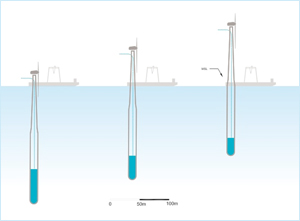Researchers Creates New Design for Low-Cost Offshore Wind Turbines

Researchers at the Department of Civil and Environmental Engineering of the Universitat Politècnica de Catalunya (UPC) have designed and patented a floating platform for offshore wind turbines that can reduce energy costs to 12 euro cents per kilowatt hour (kWh) through a more efficient design and cheaper building materials.
Researchers Climent Molins and Alexis Campos, of the UPC’s Department of Civil and Environmental Engineering, have developed a model of a floating structure for offshore wind turbines anchored at great sea depths that makes them competitive through cost savings in construction and maintenance.
The prototype, WindCrete, is a cylindrical structure with a large float and a ballast base that makes it self-stabilizing. According to the researchers, who belong to the Barcelona School of Civil Engineering, the main innovations of this model compared to similar ones on the market are the seamless, monolithic structure and the use of concrete for its construction.
By using concrete instead of the more expensive steel that has been used previously, the construction cost is reduced by 60%. In addition, concrete is more resistant in the marine environment, so the structure has fewer maintenance requirements and a life of about 50 years. The absence of joints in the platform increases its durability against the effects of wind and sea and avoids the damage that normally appears in transition areas.
Cheaper energy and easier installation
The WindCrete includes a 5-megawatt (MW) wind turbine that can carry rotors of up to 15 MW with a minimum increase in the cost, making it far more economical. The new system reduces the cost of wind energy to 12 cents per kilowatt hour (kWh). This is half the price per kWh of this type of energy (about 24 cents) in the Canary Islands, one of the regions where wind power is to be promoted.
Given the long useful life of this prototype, the possibility of replacing the turbine with a more powerful and more profitable one has been considered.
Partially submerged offshore platforms of this type require a minimum depth: 90 m in the case of WindCrete. However, there is no technical maximum depth at which they can be installed. In the Gulf of Mexico, for example, there are oil platforms of this type anchored at depths of up to 2300 m.
The WindCrete model was included in a report by the Carbon Trust association of experts in sustainability and energy published by the Scottish government on the current state of floating wind technology. The study specifically examines key trends in this technology, costs, and barriers to commercialization based on the analysis of 18 models that are currently on the market.

